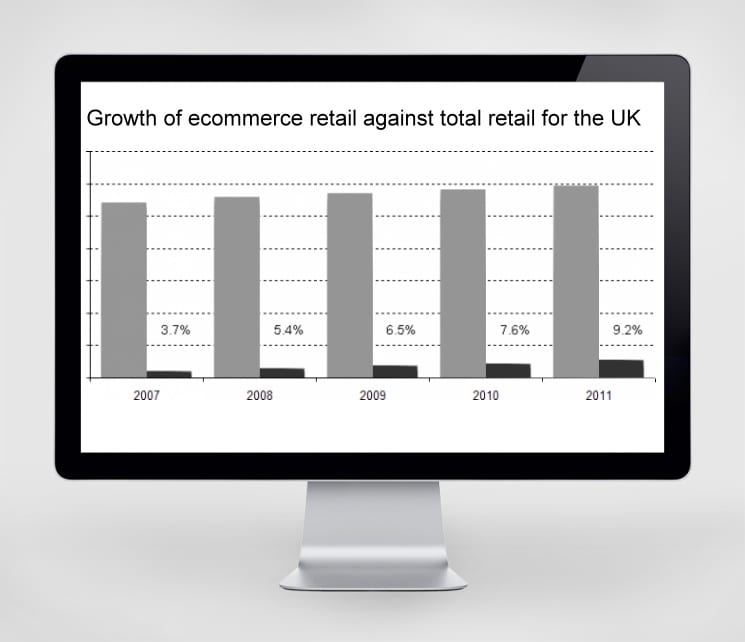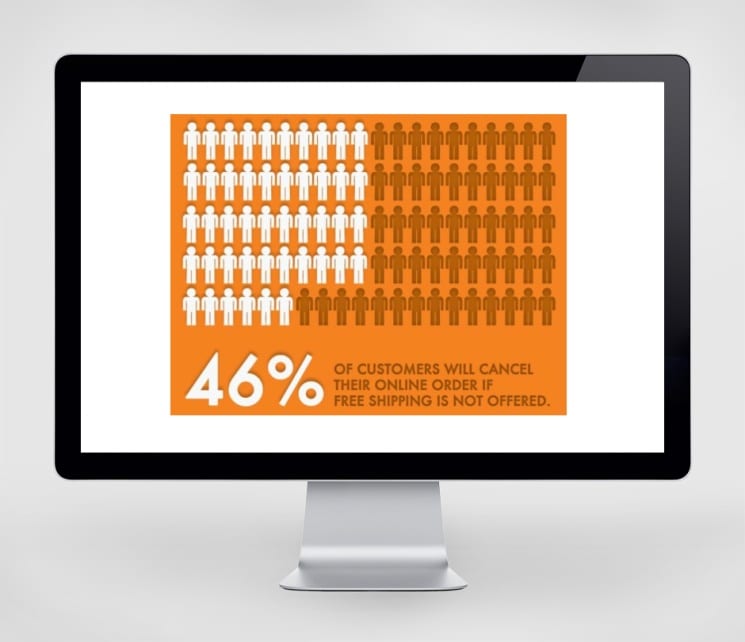This white paper is the first part of the series Ecommerce Website Design & Development White Papers. The intent of this series of white papers is to give you an understanding of best practices, strategies and design details that go into making a successful ecommerce website to help you make a more informed decision when the time comes to set up your own ecommerce store.
In Part 1, we are going to familiarise ourselves with ecommerce web design and development practices. We will take a quick look at the ecommerce best practices that we’ll cover in subsequent white papers, and we will review the latest trends and statistics in ecommerce website design.
What is Ecommerce Web Design?
When we talk about ecommerce at Vu Online, we are talking about the conventional understanding of it as ‘regular’ commerce that is conducted in an electronic environment – on a website. But ecommerce in 2012 doesn’t just mean an online shop for consumers to purchase goods. Ecommerce today has evolved to include B2B ecommerce, auction and reverse-auction platforms, advertising platforms, and marketplaces; all of which we have built recently for clients.
Web design is a mature industry today. There are many best-practice website design and development considerations that go into creating a site that is pleasant to look at and practical (and easy) to use. Our philosophy is to create a website with the greatest ‘stickiness’ by following a mantra of ‘attract, convert, repeat.’
This means ensuring that the structure of the information on the site makes sense, that the design follows understood patterns, and that the website is easily accessible by the major search engines (this is the “on-page” aspect of SEO or search engine optimisation) and that the conversion messages for the customer are clear and relevant.
In other words, we aim to build a site that people want to use.
Because ecommerce websites are transactional, there are many more design, technical and legal considerations that need to be addressed.
What follows is a high-level overview of many of the considerations that a business owner faces when setting up an ecommerce website for the first time. We will cover these topics in more depth in subsequent white papers.
How big is Ecommerce in the UK?
Big. And it’s going to get bigger. Global estimates put the value of ecommerce at £2.7 trillion by 2016.[1] That’s only four years away!
UK Trade and Investment reports that the UK is Europe’s leading ecommerce market, with the Internet economy making up 7.8% of the UK GDP in 2010 and growing 23%. By August 2011, 10% of all retail sales in the UK were online.[2]

Why should a simple shop consider an Ecommerce website?
The UK online publication New Media Age quotes the research giant Nielsen on the motivation behind online shopping that “the main reason for shopping online was cheaper prices, cited by 57% of respondents, and the ability to shop at any time (32%). An uncompromising 29% said not having to deal with sales staff was one of their three biggest motivators.”[3]
In addition, it’s quite clear that with the growth in ecommerce both here in the UK and abroad, consumers are increasingly expecting retailers to be online; not just with a website, but with a full ecommerce store. Even large retailers such as Next are increasingly relying on their Internet sales to boost falling footfall in their high street shop (see Next sales on target as online business outperforms).
Ecommerce technology overview
Websites can present a technical challenge in their own right. But, ecommerce websites require a more advanced technology to serve the products from the database, connect the store to payment gateways (so you can get your money), managing a lot of private data from consumers, and in some cases predicting and reacting to consumer purchasing behaviour.
Amazon is often cited as a leader in ecommerce, but don’t let the sophistication of Amazon cause you to think too big. All you need in order to create the kind of ecommerce ‘stickiness’ for a successful site is a clean design, a solid database, a secure payment mechanism – even PayPal – and a good strategy for reaching customers who want to buy your goods online.
Smooth functionality and a painless checkout process are part of your site’s brand experience and it’s something that the successful ecommerce sites like Amazon take very seriously.
Also, the exponential growth in smart mobile and tablet usage means that new opportunities for ecommerce have to be taken seriously. In 2011, UK retailers may have missed out on as much as £4bn in revenue due to poor mobile sites[4] while pundits proclaim 2012 to be the year of the tablet in ecommerce[5].
We will devote an entire white paper to ecommerce technology later in this year.
Ecommerce graphic design
Have you noticed that some ecommerce websites look terribly cold, uninviting and downright untrustworthy? Yet, other ecommerce stores are completely designed and branded experiences similar to the in-store experience you get walking through the front doors of a High Street shop.
Where branding for ecommerce is concerned, we believe that the website must look trustworthy, that the colours people respond to when buying online are used, and that rather than relying on someone else’s website shopping mechanisms, you need your own branded ‘real estate’ that can be the central hub of your online store and brand; your own ecommerce store online.
Ecommerce: The laws and regulations (EU/ UK)
As a retailer, you will need to observe the usual UK and EU laws. As you are selling goods ‘at a distance’ with an ecommerce shop, you will need to conform to The Distance Selling Regulations 2000 which are outlined in the OFT’s excellent Distance Selling Hub.
You will also need to ensure that your business adheres to the main body of law relating to ecommerce, The Electronic Commerce (EC Directive) Regulations 2002.
The aim of these regulations is to boost consumer confidence, rather than to restrict trade, and the UK’s legislation does bring some clarity and consistency to selling online.
Taking ecommerce payments, shipping and distribution
There are a lot of new terms that you may be unfamiliar with when setting up an ecommerce website. Payment gateways, merchant accounts, warehousing and shipping are all major considerations for the ecommerce merchant.
If you are already trading, then you probably have relationships with suppliers and distributors, and even a merchant account. However, making your product catalogue available online and allowing customers to order from your website brings with it many challenges that your current business may not face day-to-day.
Packing, labelling, weighing, shipping and returns add a layer of complexity to your existing business operations. You will need to consider carefully whether the shop and the ecommerce store should be connected, or whether their operations will be separated for logistical or operational reasons.
It may be advantageous to consider an altered or completely different brand or trade name online that works better for searching and marketing reasons.
Support and maintenance of your ecommerce website
Planning and working with your local website company in the long-term will ensure that your ecommerce website keeps running at peak performance. There are also many advantages to your business for maintaining a close relationship with your ecommerce technology vendor.
At Vu Online, we have direct experience with warehousing, shipping and ecommerce customer service technology, and we offer this expertise to our clients alongside the technical programming, maintenance and operation of the ecommerce site. This added level of knowledge can ensure the most efficient operation of the ecommerce shop and a superior level of care for your customers.
Ecommerce budget strategies
It helps tremendously to have an experienced ecommerce advisor on hand to help you set up your forecasts, budgets and payment strategies. We have a lot of experience with the hidden costs of operating an ecommerce website and many of our clients have been able to avert disaster by understanding and planning in advance for costs they could face in the future.
Arranging a beneficial retainer agreement helps keep maintenance costs low and ensures the on-going success and ‘stickiness’ of the ecommerce website. As part of our monthly ecommerce retainer, which includes reduced fees, we provide up-to-date website maintenance, SEO, AdWords campaigns, social media support, email newsletter development, and regular monthly strategy meetings to ensure everyone understands where we are going next with the plan: attract – convert – repeat.
One of the complex issues that inevitably raises its head is the question of shipping charges. There is evidence that suggests Amazon’s huge success is, at least in part, down to its free shipping campaign[6]. But does it follow from this that you’re best off not charging for shipping?

You cannot answer this question without a) knowing the place of your business in the market and b) taking a punt on your informed views, refining the interplay of the cogs and wheels in your marketing operations as time goes by.[7]
Marketing and the growth of ‘local’ online
Everyone knows that once the ecommerce website is live online, you need to get customers to arrive and begin buying. That means getting ‘traffic’ to the website. Yet, many first attempts start out ‘too big’ when building their online presence. A lot of budget can be blown by focusing on strategies that don’t yield a result.
Our advice is that unless you are already a national or global business, it is best to start marketing your ecommerce business locally. This may, at first, seem counter-intuitive; however many of the contacts and even customers that one needs to get an ecommerce business going are much easier to set up when your business is tangible to them.
Networking and building your business locally online is not only possible, it’s preferable to being another anonymous ecommerce startup. This is because other local websites can relate to a local business and local business people. You can actually go and visit the people who will be interested in your business; chat to them, organise link exchanges, and trial products with real shop customers.
In our next white paper, we will explore the advantages of starting ‘local’ online in detail and discuss some of the local marketing opportunities you can begin implementing even before your ecommerce website is designed.
If you need help with any aspect of your website, then please feel free to browse our services.
References
- BBC News, http://www.bbc.co.uk/news/business-16753902, last accessed 09.02.2012
- Digital Strategy Consulting, August 2011, via http://www.google.co.uk/intl/en/landing/internetstats/ accessed 09.02.2012, original research by the Office of National Statistcs, July 2011, http://www.ons.gov.uk/ons/rel/rsi/retail-sales/june-2011/retail-sales.pdf accessed 11.02.2012
- New Media Age, November 2010, via http://www.nma.co.uk/opinion/industry-opinion/analyst-speak-online-shoppers-spend-the-most-on-electronics-and-groceries/3020674.article accessed 11.02.2012
- New Media Age, January 2012, http://www.nma.co.uk/news/tablets-to-drive-ecommerce-in-2012/3033044.articleaccessed 11.02.2012
- New Media Age, December 2011, http://www.nma.co.uk/news/retailers-losing-out-on-%C2%A34bn-in-revenue-due-to-poor-mobile-sites/3032589.article accessed 11.02.2012
- Search Engine Journal, February 2012, http://www.searchenginejournal.com/amazon-racks-in-the-with-free-shipping-infographic/39942/. Accessed 10.02.2012
- A good article on the subject of putting the starting of an online business into perspective can be found here: Stoney De Geyter’s “Put Your Business in its Place or Your Marketing Campaign Will” in Search Engine Journal, February 2012,http://www.searchenginejournal.com/put-your-business-in-its-place-or-your-marketing-campaign-will/39663/ accessed 10.02.2012
Do you know anyone who may be interested in this project?
Click to share:
![ecommerce-website-design[1]](https://vuonline.co.uk/wp-content/uploads/2012/01/ecommerce-website-design1.jpg)



